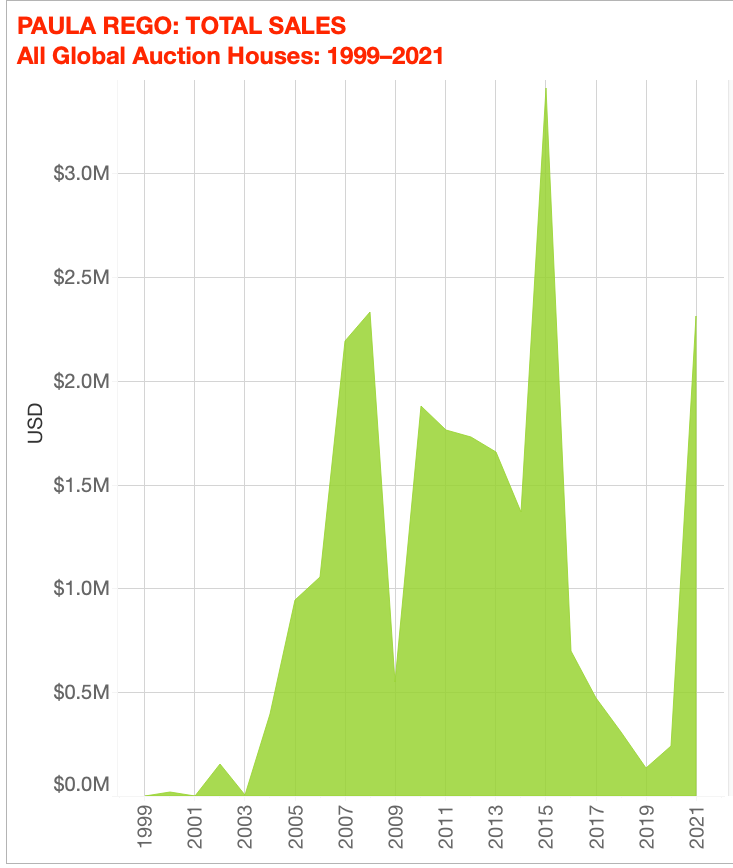The Appraisal
The 87-Year-Old Artist Paula Rego Is Set to Emerge as a Breakout Star of the Venice Biennale. Will Her Auction Market Follow?
We analyzed Rego's market performance using Artnet's Price Database.

We analyzed Rego's market performance using Artnet's Price Database.

Naomi Rea

The art world has trained its eyes on Venice ahead of the opening of the Biennale later this month, a momentous occasion that has been a star-making vehicle for many artists’ markets in years past. Interested parties have been dissecting the artist list of Cecilia Alemani’s main exhibition at the biennale, “The Milk of Dreams,” for clues as to what we can expect, and one standout name is the 87-year-old Portuguese British artist Paula Rego.
Rego’s simultaneously sublime and grotesque, unflinchingly political works—she grew up under the Portuguese dictator António de Oliveira Salazar—are a favorite of curators. She has been getting a lot of museum recognition of late, and was recently celebrated with a sprawling retrospective at Tate Britain, which just toured to the Kunstmuseum Den Haag and will open in the Museo Picasso Malaga later this month. She is also currently the subject of a solo show at the Arnolfini in Bristol, through May 29.
In Venice, Rego’s gallery Victoria Miro will double down on the moment with a solo show at its outpost in the city during the Biennale’s opening. Titled “Secrets of Faith,” the exhibition will consist of a series of works made in 2002 that depict episodes from the life of the Virgin Mary, casting the saint as more viscerally human than the ethereal portrayals we are familiar with from art history. It will be a rare treat for the market, as Rego produces slowly and had held back many of these works in her own collection until now, with one work, Descent from the Cross, hanging in her bedroom for years.
For the occasion, we used the Artnet Price Database to take a look at what has been going on with Rego’s market over the past few years.
Auction Record: $1.8 million, achieved at Sotheby’s London in July 2015
Rego’s Performance in 2021
Lots sold: 48
Bought in: 3
Sell-through rate: 94.1 percent
Average sale price: $48,146
Mean estimate: $42,224
Total sales: $2.3 million
Top painting price: $1.6 million
Lowest painting price: $1.6 million
Lowest overall price: $938, for a color lithograph from an edition of 100.

© 2022 Artnet Worldwide Corporation.
The way Rego’s politics meet figuration in her work—which deals with challenging themes such as fascism, abortion, migration, and depression—can mean that some collectors might find them more suited to a museum setting than above the dining room table. Further, her links to different historical movements coupled with the fact that she is still a living, working, artist make her difficult to pigeonhole within easy-to-sell market trends.
Still, change is afoot in Rego’s market. She left her longtime gallery, Marlborough, for Victoria Miro in October 2020, and it will be intriguing to see the fruits of the switch-up (Cristea Roberts represents the artist in print works). Meanwhile, while there is certainly activity on the primary and private secondary market, auction supply is crunched, so this data can only tell us so much about what has been going on.
Until now, Rego has hardly been a market darling, but her work has found a steady, dedicated audience that appreciates her talent as a painter as well as her historical significance—her 1998 abortion series has been credited with helping to liberalize laws around it in Portugal. It will be interesting to observe whether more work will make an appearance in the public sphere following the more global awareness that will be brought to her work in Venice— particularly in a moment when many collectors are keen to add major works by previously undervalued artists, particularly women, to their collections.